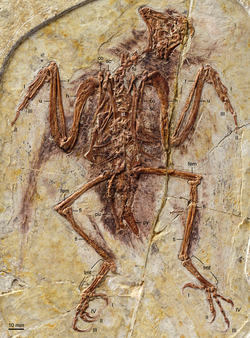| Beiguornis Temporal range: Early Cretaceous, | |
|---|---|
| Scientific classification | |
| Kingdom: | Animalia |
| Phylum: | Chordata |
| Class: | Reptilia |
| Clade: | Dinosauria |
| Clade: | Saurischia |
| Clade: | Theropoda |
| Clade: | Avialae |
| Clade: | † Enantiornithes |
| Family: | † Bohaiornithidae |
| Genus: | † Beiguornis Wang et al., 2022 |
| Species: | †B. khinganensis |
| Binomial name | |
| †Beiguornis khinganensis Wang et al., 2022 | |
Beiguornis is a genus of bohaiornithid dinosaurs from the Early Cretaceous Longjiang Formation of Inner Mongolia, China. The genus contains a single species, Beiguornis khinganensis. Beiguornis is the first and only enantiornithine known from the Longjiang Formation. In the phylogenetic analysis conducted by the describing authors, Beiguornis formed a monophyletic group with the bohaiornithids Sulcavis and Zhouornis . [2]


